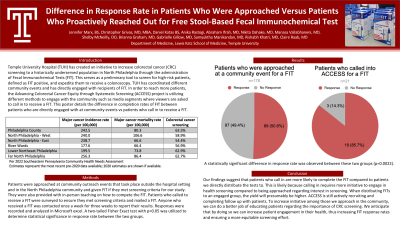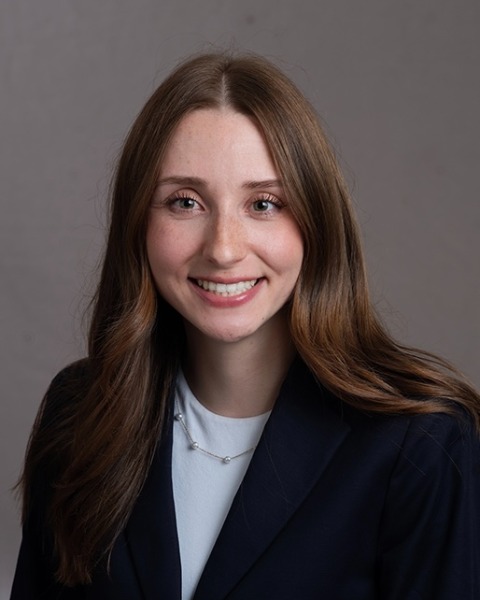Monday Poster Session
Category: Colorectal Cancer Prevention
P2112 - Difference in Response Rate in Patients Who Were Approached Versus Patients Who Proactively Reached Out for Free Stool-Based Fecal Immunochemical Test (FIT)
Monday, October 28, 2024
10:30 AM - 4:00 PM ET
Location: Exhibit Hall E

Has Audio

Jennifer Marx, BSN
Lewis Katz School of Medicine at Temple University
Philadelphia, PA
Presenting Author(s)
Jennifer Marx, BSN1, Christopher Grivas, MD, MBA2, Daniel Kotas, BS1, Anika Rastogi, 3, Abraham Ifrah, MD2, Nikita Dahake, MD4, Manasa Vallabhaneni, MD2, Shelby McNeilly, DO4, Brianna Graham, MD2, Gabrielle Gillow, MD2, Samyuktha Manikandan, MD2, Rishabh khatri, MD5, Claire Raab, MD6
1Lewis Katz School of Medicine at Temple University, Philadelphia, PA; 2Temple University Hospital, Philadelphia, PA; 3Lewis Katz School of Medicine at Temple University, Blue Bell, PA; 4Temple University, Philadelphia, PA; 5Lewis Katz School of Medicine at Temple University, New Haven, CT; 6Temple Health, Philadelphia, PA
Introduction: Temple University Hospital (TUH) has created an initiative to increase colorectal cancer (CRC) screening to a historically underserved population in North Philadelphia through the administration of Fecal Immunochemical Tests (FIT). This serves as a preliminary tool to screen for high-risk patients, defined as FIT positive, and expedite them to receive a colonoscopy. TUH has coordinated different community events and has directly engaged with recipients of FIT. In order to reach more patients, the ACCESS project is utilizing different methods to engage with the community such as media segments where viewers are asked to call in to receive a FIT. This poster details the difference in completion rates of FIT between patients who are directly engaged with at community events vs patients who call in to receive a FIT.
Methods: Patients were approached at community outreach events that took place outside the hospital setting and in the North Philadelphia community and given FIT if they met screening criteria for our study. They were also provided with in-person teaching on how to compete the FIT. Patients who called to receive a FIT were surveyed to ensure they met screening criteria and mailed a FIT. Anyone who received a FIT was contacted once a week for three weeks to report their results. Responses were recorded and analyzed in Microsoft excel. A two-tailed Fisher Exact test with p< 0.05 was utilized to determine statistical significance in response rate between the two groups.
Results: As of date, we have analyzed a total of 197 patients. 176 patients were enrolled at community events and a total of 89 responses were recorded, making the overall response rate 50.6%. 21 patients enrolled after proactively reaching out to the team and a total of 18 responses were recorded, making the overall response rate 85.7%. A Fisher Exact test found a statistically significant difference in response rate between these two groups (p=0.0022).
Discussion: Our findings suggest that patients who call in are more likely to complete the FIT compared to patients we directly distribute the tests to. This may be due to patients who call in having to use more initiative to receive a FIT compared to the other group. Therefore, ACCESS can do a better job of educating patients in the community regarding the importance of CRC screening to increase motivation and initiative to complete the FIT and increase response rates, thus truly ensuring an equitable screening effort.
Disclosures:
Jennifer Marx, BSN1, Christopher Grivas, MD, MBA2, Daniel Kotas, BS1, Anika Rastogi, 3, Abraham Ifrah, MD2, Nikita Dahake, MD4, Manasa Vallabhaneni, MD2, Shelby McNeilly, DO4, Brianna Graham, MD2, Gabrielle Gillow, MD2, Samyuktha Manikandan, MD2, Rishabh khatri, MD5, Claire Raab, MD6. P2112 - Difference in Response Rate in Patients Who Were Approached Versus Patients Who Proactively Reached Out for Free Stool-Based Fecal Immunochemical Test (FIT), ACG 2024 Annual Scientific Meeting Abstracts. Philadelphia, PA: American College of Gastroenterology.
1Lewis Katz School of Medicine at Temple University, Philadelphia, PA; 2Temple University Hospital, Philadelphia, PA; 3Lewis Katz School of Medicine at Temple University, Blue Bell, PA; 4Temple University, Philadelphia, PA; 5Lewis Katz School of Medicine at Temple University, New Haven, CT; 6Temple Health, Philadelphia, PA
Introduction: Temple University Hospital (TUH) has created an initiative to increase colorectal cancer (CRC) screening to a historically underserved population in North Philadelphia through the administration of Fecal Immunochemical Tests (FIT). This serves as a preliminary tool to screen for high-risk patients, defined as FIT positive, and expedite them to receive a colonoscopy. TUH has coordinated different community events and has directly engaged with recipients of FIT. In order to reach more patients, the ACCESS project is utilizing different methods to engage with the community such as media segments where viewers are asked to call in to receive a FIT. This poster details the difference in completion rates of FIT between patients who are directly engaged with at community events vs patients who call in to receive a FIT.
Methods: Patients were approached at community outreach events that took place outside the hospital setting and in the North Philadelphia community and given FIT if they met screening criteria for our study. They were also provided with in-person teaching on how to compete the FIT. Patients who called to receive a FIT were surveyed to ensure they met screening criteria and mailed a FIT. Anyone who received a FIT was contacted once a week for three weeks to report their results. Responses were recorded and analyzed in Microsoft excel. A two-tailed Fisher Exact test with p< 0.05 was utilized to determine statistical significance in response rate between the two groups.
Results: As of date, we have analyzed a total of 197 patients. 176 patients were enrolled at community events and a total of 89 responses were recorded, making the overall response rate 50.6%. 21 patients enrolled after proactively reaching out to the team and a total of 18 responses were recorded, making the overall response rate 85.7%. A Fisher Exact test found a statistically significant difference in response rate between these two groups (p=0.0022).
Discussion: Our findings suggest that patients who call in are more likely to complete the FIT compared to patients we directly distribute the tests to. This may be due to patients who call in having to use more initiative to receive a FIT compared to the other group. Therefore, ACCESS can do a better job of educating patients in the community regarding the importance of CRC screening to increase motivation and initiative to complete the FIT and increase response rates, thus truly ensuring an equitable screening effort.
Disclosures:
Jennifer Marx indicated no relevant financial relationships.
Christopher Grivas indicated no relevant financial relationships.
Daniel Kotas indicated no relevant financial relationships.
Anika Rastogi indicated no relevant financial relationships.
Abraham Ifrah indicated no relevant financial relationships.
Nikita Dahake indicated no relevant financial relationships.
Manasa Vallabhaneni indicated no relevant financial relationships.
Shelby McNeilly indicated no relevant financial relationships.
Brianna Graham indicated no relevant financial relationships.
Gabrielle Gillow indicated no relevant financial relationships.
Samyuktha Manikandan indicated no relevant financial relationships.
Rishabh khatri indicated no relevant financial relationships.
Claire Raab indicated no relevant financial relationships.
Jennifer Marx, BSN1, Christopher Grivas, MD, MBA2, Daniel Kotas, BS1, Anika Rastogi, 3, Abraham Ifrah, MD2, Nikita Dahake, MD4, Manasa Vallabhaneni, MD2, Shelby McNeilly, DO4, Brianna Graham, MD2, Gabrielle Gillow, MD2, Samyuktha Manikandan, MD2, Rishabh khatri, MD5, Claire Raab, MD6. P2112 - Difference in Response Rate in Patients Who Were Approached Versus Patients Who Proactively Reached Out for Free Stool-Based Fecal Immunochemical Test (FIT), ACG 2024 Annual Scientific Meeting Abstracts. Philadelphia, PA: American College of Gastroenterology.

